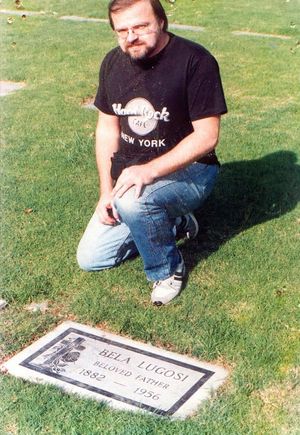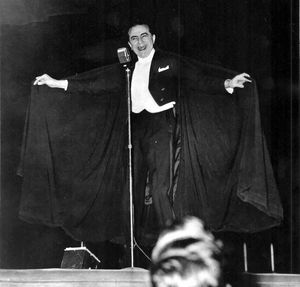 by Professor Kinema (Jim Knusch)
by Professor Kinema (Jim Knusch)
In one of life's little oddball quirks, it's truly ironic that a man who's most famous alter ego, Count Dracula, repelled by a crucifix or holy cross, would find his final rest in a place named the Holy Cross Cemetery. He was born Béla Ferenc Dezsõ Blaskó on October 20, 1882, Lugos, Austria-Hungary (now Lugoj, Romania).
In 1931 he became an American citizen, taking the name Béla Lugosi.
 On August 16, 1956, at the age of 73 he died, alone, of a heart attack in his home, an apartment on a street named Harold Way, off of Hollywood Blvd. His fifth wife of one year, Hope (more than 30 years his junior), had gone out to buy some groceries. She returned around 7 pm to find him dead.
On August 16, 1956, at the age of 73 he died, alone, of a heart attack in his home, an apartment on a street named Harold Way, off of Hollywood Blvd. His fifth wife of one year, Hope (more than 30 years his junior), had gone out to buy some groceries. She returned around 7 pm to find him dead.
He had been working with Ed Wood on a loose film project that was supposedly to be called The Ghoul Goes West, or The Phantom Ghoul, or Dr. Acula, or something equally as wacky. Richard Bojarski, in his book The Films of Bela Lugosi, also mentions The Vampire's Tomb and Revenge of the Dead as working titles. Accordingly (some sources say) Lugosi was clutching a copy of the script for yet another wacky Ed Wood project titled The Final Curtain.
The final film he lived to see and benefit from was The Black Sleep. The final film listed in his filmography is, of course, the appropriately wacky Plan 9 From Outer Space. The existing final footage of Lugosi that was ultimately tacked into this film gives no clue as to what project Wood had in mind when he was shooting it. Ironically at least, it does show Béla spreading his Dracula cape onscreen for the last time–possibly the cape he is buried in.
Hope Lininger, a clerk in a film studio editing department and devoted fan, had met Béla while he was in drug rehab and soon after married him. According to some reports, a good portion of his medical treatment was paid for by Frank Sinatra. Consequently, Bela's burial costs were also paid for by Sinatra. Some reports say Sinatra considered Béla a 'pal,' while others state that he had never even met him. Around 60 people attended Béla's funeral, including his son Béla Jr, fourth wife Lillian, Ed Wood, director Zoltan Korda, actress Carol Borland and 'Unkka' Forry Ackerman.
 While continually playing Dracula for one theatre group or another throughout his life, he possessed a few appropriate outfits. One, complete with cape, he took with him to his grave. Another made it's way to the vast collection of Forry Ackerman. At one point, during one of my few visits to the Ackermansion, I wore the cape for a few minutes. Tim Burton's film Ed Wood correctly shows him in his coffin decked out in one of his Dracula outfits, but incorrectly shows only a few people attending the funeral.
While continually playing Dracula for one theatre group or another throughout his life, he possessed a few appropriate outfits. One, complete with cape, he took with him to his grave. Another made it's way to the vast collection of Forry Ackerman. At one point, during one of my few visits to the Ackermansion, I wore the cape for a few minutes. Tim Burton's film Ed Wood correctly shows him in his coffin decked out in one of his Dracula outfits, but incorrectly shows only a few people attending the funeral.
At Holy Cross Cemetery, in Culver City, LA (not far from LAX) his plot location is Grotto, L120, 1. Nearby are the final resting places of Bing Crosby and Sharon Tate. While visiting the gravesite, I could only wonder, He died alone, he's here alone. Will any family members still alive eventually be buried here with him?
Yet perhaps the biggest irony associated with Béla could be one of his noted quotes – that could almost serve as his epitaph: (on playing the 'undead' Dracula) "It's a living, but it's also a curse. It's Dracula's curse."
